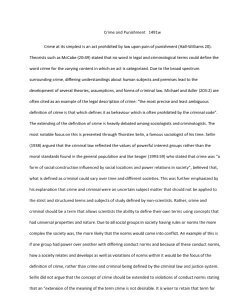Crime and Punishment Crime at its simplest is an act prohibited by law upon pain of punishment (Hall-Williams 20). Theorists such as McCabe (20:49) stated that no word in legal and criminologic1491w
Crime and Punishment Crime at its simplest is an act prohibited by law upon pain of punishment (Hall-Williams 20). Theorists such as McCabe (20:49) stated that no word in legal and criminologic1491w
Crime and Punishment 1491w
Crime at its simplest is an act prohibited by law upon pain of punishment (Hall-Williams 20). Theorists such as McCabe (20:49) stated that no word in legal and criminological terms could define the word crime for the varying content in which an act is categorized. Due to the broad spectrum surrounding crime, differing understandings about human subjects and premises lead to the development of several theories, assumptions, and forms of criminal law. Michael and Adler (203:2) are often cited as an example of the legal description of crime: “the most precise and least ambiguous definition of crime is that which defines it as behaviour which is often prohibited by the criminal code”. The extending of the definition of crime is heavily debated among sociologists and criminologists. The most notable focus on this is presented through Thorsten Selin, a famous sociologist of his time. Sellin (1938) argued that the criminal law reflected the values of powerful interest groups rather than the moral standards found in the general population and like Seager (1993:59) who stated that crime was “a
